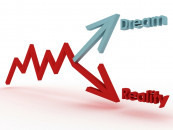Retail investors lead rally at Asia’s best market
With falling interest rate across globe, investors flock to riskier assets

It has been pouring, not raining, when it comes to Pakistan’s economy for quite a few years, as we face one crisis after another. Although the skies are somewhat clear in Karachi, dark clouds are still looming over the country’s economy.
As per recent tweet of Commerce Adviser Abdul Razak Dawood, exports have declined 19.5% year-on-year due to the disruption caused by monsoon rains in the country’s financial hub. The government has already announced a negative gross domestic product (GDP) growth of 0.38% for the outgoing fiscal year.
Not far from the main street where business sentiment is at a multiyear low, there seems to be huge celebration at the Pakistan Stock Exchange (PSX), which is now leading the pack of Asian equity markets and ranked fourth best equity market globally.
The trading volume surpassed the historic one-billion mark by breaking all records. Unexpectedly, it is the individual investor that did all the heavy lifting this time when such investors rolled up their sleeves and entered at market bottoms in February and kept buying on its way up.
Institutions joined the party a little later as their hands were tied due to increased redemption calls amid the rising Covid-19 cases.
Participation of retail investors is not a phenomenon witnessed in Pakistan’s market only. Even the historic rise in the S&P 500 index of the US stock market since reaching the depth of the pandemic in March was mainly led by retail investors.
Additionally, with falling interest rate across the globe, investors are flocking to riskier assets in search for yield as well as growth. Falling dollar value is also making other asset classes more attractive such as gold, which has recently taken a breather after hitting multiyear highs of $2,000 per ounce.
The continuously diminishing profit rates of National Savings Schemes (NSS) and falling transactions in the real estate sector due to Covid-19-related restrictions and a tightening tax regime have forced investors to venture into other avenues and mouth-watering valuations at the PSX in March gave them the opportunity of a lifetime.
It is futile to call top and bottom of any rally, however, history tells us that Wall Street cannot stay disconnected with the main street for very long and sooner or later investors have to face the reality. So far the narrowing current account deficit and the falling Covid infection rate have been touted as the major factors fuelling the recent rally.
However, let’s not forget that the reduction in the current account deficit has been achieved by clamping down on imports and not by increasing exports. Those imports, which largely consisted of raw material and machinery, were reduced as many businesses scrapped expansion plans during the high interest rate environment long before the pandemic hit our shores.
The depreciation of rupee against the dollar also increased the input cost of local businesses, which was eventually passed on to consumers eg the rise in automobile prices over the past many months despite the fall in demand.
On the other hand, the pandemic is rearing its head again globally and it seems that we have lowered our guards too fast and too soon and no one seems to be taking it seriously anymore when it comes to the precautionary measures.
Even the most conservative market analysts do not want to appear as a party pooper and are trying their best to sing along as long as they can.
Although no party lasts forever, it seems that the tables are turned this time as it is the individual investor who kicked off the rally and it will be interesting to see who will call the top first and who will exit timely before profits turn into mice and pumpkin.
The writer is a financial market enthusiast and attached to Pakistan’s stocks, commodities and emerging technology
Published in The Express Tribune, September 7th, 2020
Like Business on Facebook, follow @TribuneBiz on Twitter to stay informed and join in the conversation.



















COMMENTS
Comments are moderated and generally will be posted if they are on-topic and not abusive.
For more information, please see our Comments FAQ